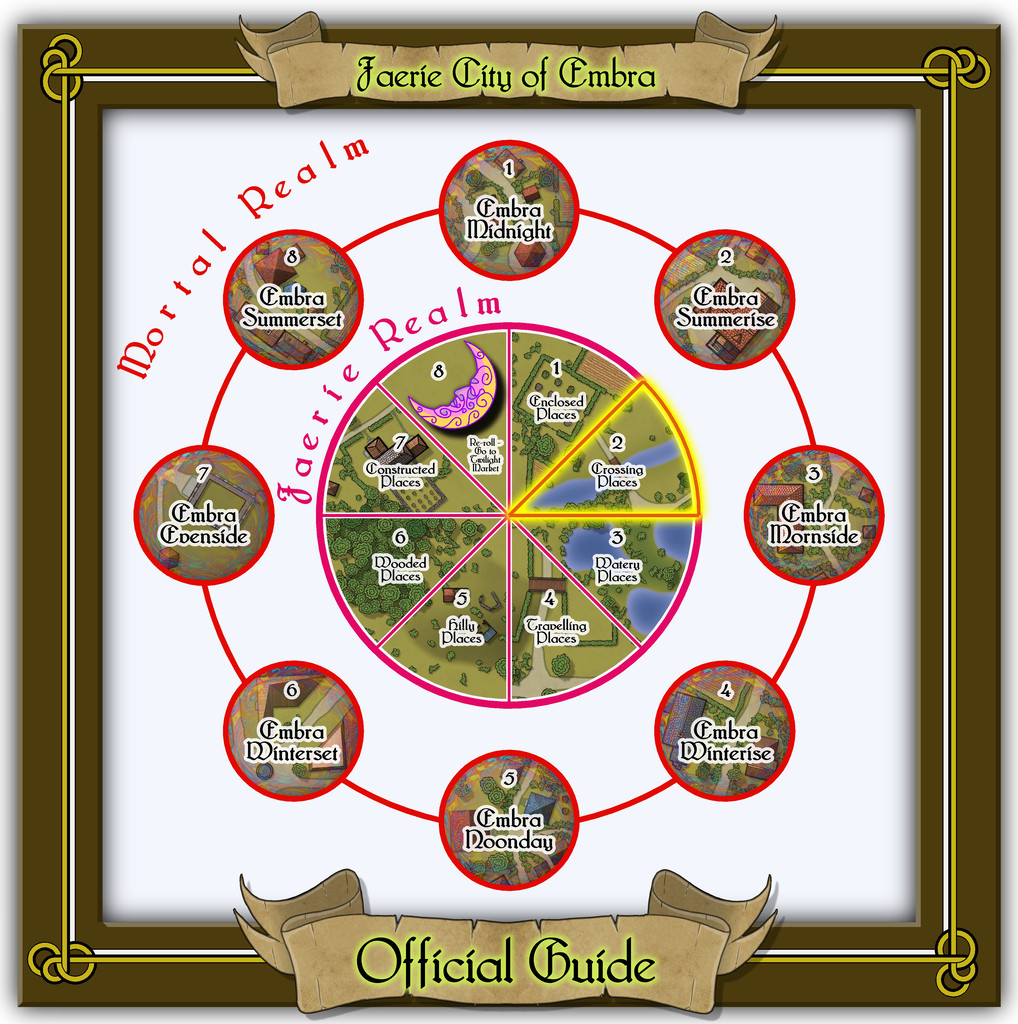Community Atlas: Embra - Crossing Places
 Wyvern
🖼️ 271 images Cartographer
Wyvern
🖼️ 271 images Cartographer
Having discussed the design ideas, methods and overall appearances/layouts for the various Embra "Places" maps in the opening Enclosed Places topic, I'll not reiterate those points here, unless relevant. So moving on, the second set of Places of Interest the Embra "Official Guide" map gives access to, are the Crossing Places:
I thought a simpler criss-cross kind of frame corner decoration might be interesting here, partly inspired by that used for the Official Guide map. While the lines along the map edges are easily drawn in CC3+, there was a more elaborate corner-piece in another of the Dover Clip-Art "Celtic Borders on Layout Grids" hardcopy book designs that I thought would add a little more elegance to this map than my own clumsy efforts were able to achieve. As was established for the first of these "Places" link-maps, the link-spaces themselves are just labelled extracts from the actual maps, with added notes for the benefit of GMs, and further reminders in the accompanying text and PDF files. The seven streets condensed into one map here makes for fewer links than some of the "Places" diagrams, though it did mean making that link point larger, to fit all the names in. As luck had it, I somehow managed to get the dragon in just the right place here to avoid running into problems with it wanting to feature itself in others of the link-squares when I added the Dragon Bridge map extract, as of course it's a complete symbol, considerably enlarged, not something that can be easily dismantled to stop it from doing that otherwise!








Comments
The first Crossing Place is Fountain Bridge:
This has a small, scattered village on its central island, for which a toggle in the Atlas FCW file should allow the simple interior layouts to be seen (all have just a single storey):
On this somewhat more detailed view, it may be possible to make out that the two bridges seem a little odd - they appear to be translucent. This is not a mistake, as there are no solid, permanent bridges here in fact. Both are literal water-fountain features. The travellers stand atop one of the square stone bridge abutments, and are then catapulted across in a gentle arc by a tremendous pulse of water. They arrive dry and safe a few seconds later on the opposite abutment - unless someone panics, in which case, they may end up getting wet, or even dropping into the river, to be rescued by the omnipresent water faeries, who think such a thing a tremendous joke! Animals - except magical or Faerie types - cannot use the bridges at all, however. Text and PDF files explain a little more, although Eerie Wood and Eerie House remain as mere mysterious names, to be expanded only should GMs wish to do so.
The next Place is Dragon Bridge, which of course is a Bridge along the back of a great sleeping Dragon (what else?):
An explanation for how this works is provided by the featured text alongside the map, and the larger elements from that - rocky mounds, golden discs, trees and coloured boulders - have been placed on the map itself. It's clearly been working for a long time, judging by the wooden village that has grown along the Dragon's back, spilling over onto both river banks.
Interiors for the buildings should be available via the usual FCW file toggle in the Atlas (next image), with a second toggle for the upper storey interior of the Honeydew Inn (lower next image):
As commented already, the Dragon is a symbol, from DD3, but greatly enlarged. It's also a varicolor one, with added purple polygons to match the description of the featured text. As ever, there'll be PDF and text file notes available in the Atlas, which will tell you more about those mysterious, subterranean Pixie Roads through Kelliwick Ridge...
The last of the individual Crossing Places maps covers the part of the Twilight Market here, Slateford Market (with a second view below showing just the map, hopefully for a little better clarity at the typical Forum resolution):
That the road layout and market stall placements look like the wings of a butterfly is not accidental. The original Judges Guild map on which this was based only had the layout on one side of the stream. It was though obvious that a simple ink-blot-style mirror image would produce this more pleasing pattern, thus this segment of the Twilight Market was designed with that in mind. Of course there's a watcher at the ford (from the featured text), and some more of the Mike Schley tree-houses, including an aerial tavern in the bough-structure overhanging the River Clack in the Butterfly Tree, "The Tasty Drop" (also a comment on patrons who miss their footing and end up in the Clack below...).
There aren't any actual buildings here however, simply tents, stalls, awnings, wagons and several open-plan covered spots (including a pair of green-tiled, circular bandstands). The thatched buildings in the treetops are intended as living parts of the trees, so aren't real buildings as such. Or that was my excuse for not providing interior layouts for them anyway!
Lastly, the fourth map covers the seven Crossing Places Streets in one:
Which of course is tricky to see much detail on at this size, so some closer views might help:
Two of these are obviously bridge-style crossings, albeit in rather unusual ways. Spiderweb Way suspends part of its street, its paths and buildings high above an Inlet of the sea, for all Embra is in the most landlocked part of all my Errynor maps. This is, however, Faerie, so think more surrealist thoughts, and it all starts to make perfect sense. If it doesn't, you just need to think more surreally... Seafield Road too suspends part of itself high above a deep, rocky ravine, although one that nobody ever seems to have managed to get down into. Like the sea Inlet, is it real? Or illusory? Naturally, choosing which Place of this pair was to have the sea inlet was quite deliberate; can't make things too obvious in Faerie always, after all!
One more street, Ferry Road, has a ferry across the River Clack at its end, but the other four are all narrow ways linking broader routes that are completely ignored and unnamed here. For clearly, only the Crossing Places matter in this case! Naturally, each of these smaller streets has features all their own too - the odd, wailing music along The Remin is only one curiosity (yes, that's NOT mentioned in the featured texts, only in the text and PDF files), as the houses there appear to be made of thorny bushes, for instance.
Now we only have five more "Places" groups to discuss...
I'm quite a bit behind yet, but here are these maps included in the atlas:
Yes, there are a lot of mine, Jim's and Ricko's to go
Not a problem, Remy. There are 58 of mine in this set alone, and I know I tend to add extra complexities too.
In addition to all this (behind the scenes), we ran into a problem with a rogue fcw32.pal file I didn't even know I had, so some of the colours on the initial maps from the Embra set entered into the Atlas were wrong, and those files had to be changed, aside from everything else...
On the upside, I see we're rapidly closing-in on 750 Atlas maps now, and I'd guess once all the oustanding ones have been added, we'll likely surpass the 800 mark.
Might need to start thinking of that 1000-map contest shortly at this rate 😉
You'll never catch me ! Why yes, that is a challenge to the mappers here. See if you can exceed my map numbers submitted to the Atlas ! Bwa-hahaha !
( Sorry Remy.)
And at this current Galactic Time, I have 170 maps in the Atlas.
No Actual Ferry boat on the maps correct? I saw a Ferry Dock..looking to see if there is something already made that looks like a 1920's Ferry.. I may have to put some wooden parts together and call it a Ferry.
There is a boat at the ferry crossing landing on Ferry Road, but it's a sailboat.
Ferries don't even need to be especially boat-shaped, of course, as something like a square plank raft will do, particularly of the kind that uses pull-ropes to cross the watercourse. Some of those types were still in use in places well into the 20th century (notably the more rural areas, and on relatively narrow crossings). Depends what you need, where and when.